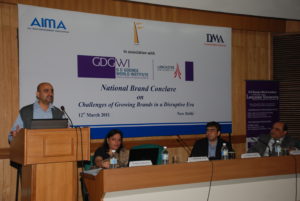Challenges of Growing Brands in a Disruptive Era
 Rohan Ubriani is the Founder & CMD of Flame Communications Pvt. Ltd. & its Digital Marketing arm, iFlame. An MBA from Bombay University, he has over two decades of rich experience in Advertising, Branding; and Digital & Social Media industry. He has handled many MNC & reputed Indian Brands while working with leading global advertising networks like JWT Worldwide, Grey Worldwide, Bates Worldwide, and have contributed to an array of iconic brands like Otis, HCL-HP, Taj Hotels, Ambuja and UNICEF. He is a visiting/guest faculty at leading B-Schools and his lectures have been telecast over National TV Network (available on YouTube (http://www.youtube.com/user/FlameCommunications). He can be reached at rohan.ubriani@gmail.com
Rohan Ubriani is the Founder & CMD of Flame Communications Pvt. Ltd. & its Digital Marketing arm, iFlame. An MBA from Bombay University, he has over two decades of rich experience in Advertising, Branding; and Digital & Social Media industry. He has handled many MNC & reputed Indian Brands while working with leading global advertising networks like JWT Worldwide, Grey Worldwide, Bates Worldwide, and have contributed to an array of iconic brands like Otis, HCL-HP, Taj Hotels, Ambuja and UNICEF. He is a visiting/guest faculty at leading B-Schools and his lectures have been telecast over National TV Network (available on YouTube (http://www.youtube.com/user/FlameCommunications). He can be reached at rohan.ubriani@gmail.com
Given below is the keynote address delivered by him at National Brand Conclave on “Challenges of Growing Brands in Disruptive Era” India Habitat Centre, New Delhi – in the capacity of Conclave Director. Flame has conceptualized this Conclave, arranged eminent speakers from industry & academia and successfully marketed this prestigious event for sponsorships & participation.
Oxford Dictionary defines the word ‘disrupt’ as ‘ interrupt (an event, activity, or process) by causing a disturbance or problem; drastically alter or destroy the structure of ( something).
Disruptive approach to developing effective marketing strategies is the new global order in a dynamic marketplace today where traditional marketing strategies lead to very lukewarm or virtually no gain, causing loss of precious resources. How? Lets examine the role of Traditional Marketing Strategies till about a decade back & now.
Traditional Marketing Strategies usually seek to build brands by revolving around good old tools of Market Segmentation, Positioning, Unique Selling Propositions (USPs), Creation of Points of Difference (PODs) on platforms of quality connotations, pricing edges, distribution strengths (National or Local Brand tags), varied applications, real or perceived benefits, fear psychosis, promotional schemes etc.
While they still are necessary to indulge into, they do not guarantee success today as they used to, in the older times. Why? Because today, every competitors has resources to convert your POD in to POPs (Points of Parity). And also because the consumers today have very little time to spend on the Brand messages as compared to yesteryears, giving you less time to do more. And with heighten, cut-throat competition – in terms of sheer number of competitors and their elevated aggression, the task of building brands is far more complex today, and hence traditional Marketing Tools for Building brands are not sufficient anymore.
Disruptive Marketing: A discovery, not an invention
It is not that disruptive marketing did not exist earlier. It sure did, when Godrej introduced ‘Puf’ – an acronym for ‘Poly Urethane Fibre, which was hitherto a relatively new insulation material in their refrigerators (as compared to glass wool used earlier). Their ads talked very proudly about Godrej containing “Puf’ and reinforced it by carrying an image of Superman-looking graphic, with ‘Puf’ written boldly across his chest which helped immensely in quick registration & recall). And through this master stroke, Godrej indirectly insinuated that other competing brands of refrigerator did not have “Puf”, although, by then, “Puf” was an integral element of all refrigerators.
Immediately after Godrej’s claims in media, many competitors, including Kelvinator, came up with ad campaigns, which said “Puf’ was there in their refrigerators for years, but no one bought the fact. Godrej had become Neil Armstrong of this category at that point of time.
Or, for that matter, Promise toothpaste came out with their ads saying ‘it contains clove oil’, which was a well-established home remedy for toothache in India for many decades, if not centuries. Clove Oil is an essential ingredient of virtually all toothpastes manufactured in India. It succeeded in stealing the thunder from other giants in the market like Colgate, Cibaca etc. Once again, competitors did mention in their communications later that their toothpastes too contained Clove Oil, but it did cut any ice with the consumers. The rug had been pulled out from under their feet.
These are a couple of classic Disruptive marketing illustrations of a few decades back. The point here is that, at that time, the practitioners of Brand Building (which primarily included Ad Agencies, Brand Managers, and the Top Management of client organizations) accidentally stumbled upon these strategies, while brainstorming on Traditional Marketing Strategies.
The New Paradigm
Today, leading Brand professionals, having done the basic home work of developing traditional Marketing Strategies, intentionally focus on generating Disruptive Marketing Strategies as an integral part of their duties, and implement them collectively with the launch or re-launch of a brand. It is simply because marriage (a metaphor for brand success) is as expensive today as the funeral (a metaphor for brand failure).
Thus we have seen recently quite a number of Brands practicing disruptive marketing as a way of life. Domino’s Pizza (with their 30 minute guaranteed service) & McDonald’s Indianising their burgers (McAloo Tikki Burger) have sent Nirula’s – a place of pride for us to go to till a few years back, into oblivion. PVR, M2K, Fun Cinemas etc, the new age movie places, have made traditional cinema houses eminently downmarket & therefore avoidable. Why, even our good ol’ namkeen & sweets have been branded by Lehar, Haldiram’s & Bikaner, much to the chagrin of our neighbourhood sweet shop owners who find very few takers these days.
All these visionaries saw what people are going to expect, with the advent of modern times. They played to consumers’ rising aspirations. And who thought water could ever be branded and sold at a such premium prices, when people were satisfied with buying much less costly water from rickety water vending machines on the roadside (today you will take it as an offence if someone even suggests you to do so).
If you look around, many of the products or services that we buy regularly are under tremendous pressure to remain relevant & exciting through disruptive marketing, which is not possible through traditional marketing strategies alone.
A Word of Caution
In late eighties, Fusion Water Tanks created a big stir by claiming ‘ six critical features Syntax doesn’t have’. Syntax took Fusion to court and received damages by proving that the features Fusion talked about were not critical in nature.
While Godrej & Promise were early practitioners of Disruptive Marketing (by accident), they did not capitalize much on their victories with the passage of time. While Amul Butter, with the continuation of their trademark little chubby girl and focus on humourizing current events till date is the market leader with competition nowhere in sight. Amul Butter never talks about the quality of butter, price, utility advantages over its competitors, directly or indirectly.
Moral of the stories: do not lay claims which can be successfully refuted by competition; you could then be writing your own brand’s obituary. Second, do not sit on your laurels; keep reinventing your brand to remain relevant & desirable. A Brand should, on a continuous basis, not only meet the utility requirements of its consumers, but also their changing aspirations. Hence re-invention is must on a regular basis, keeping its core values intact.
And lastly, you should always expect & be ready to counter your competitors’ Disruptive Marketing Actions. And how do you do that?
Instead of merely & sheepishly claiming later that your brand too has that advantage (that ingredient or element), or simply imitating it to look me-too (converting competitor’s POD to POP), its advisable to ensure your brand is at par with your competitor and mention it in your communication but without highlighting it prominently, and more importantly, hit back with a more powerful disruptive action, which will require some serious cerebral work by the brand building teams on both sides, Ad Agencies & Client organization.
